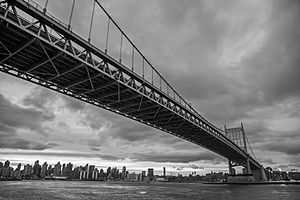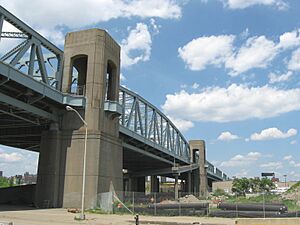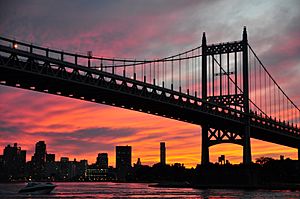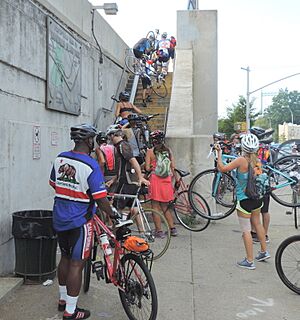Triborough Bridge facts for kids
Quick facts for kids Robert F. Kennedy Bridge(Triborough Bridge) |
|
|---|---|
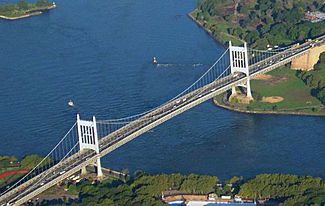
|
|
| Coordinates | 40°46′50″N 73°55′38″W / 40.780488°N 73.927168°W |
| Carries | 8 lanes of 6 lanes of NY 900G (Manhattan span) |
| Crosses | East River, Harlem River and Bronx Kill |
| Locale | New York City, United States |
| Official name | Robert F. Kennedy Bridge |
| Other name(s) | RFK Triborough Bridge, Triboro Bridge, RFK Bridge |
| Maintained by | MTA Bridges and Tunnels |
| Characteristics | |
| Design | Suspension bridge, lift bridge, truss bridge |
| Total length | 2,780 feet (850 m) (Queens span) 770 feet (230 m) (Manhattan span) 1,600 feet (490 m) (Bronx span) |
| Width | 98 feet (30 m) (Queens span) |
| Longest span | 1,380 feet (420 m) (Queens span) 310 feet (94 m) (Manhattan span) 383 feet (117 m) (Bronx span) |
| Clearance above | 14 feet 6 inches (4.42 m) (Queens/Bronx spans) 13 feet 10 inches (4.22 m) (Manhattan span) |
| Clearance below | 143 feet (44 m) (Queens span) 135 feet (41 m) (Manhattan span when raised) 55 feet (17 m) (Bronx span) |
| History | |
| Opened | July 11, 1936 |
| Statistics | |
| Daily traffic | 95,552 (Queens–Manhattan and Bronx–Manhattan, 2016) 83,053 (Queens–Bronx, 2016) |
| Toll | As of March 31, 2019[update], $9.50 (Tolls By Mail and non–New York E-ZPass); $6.12 (New York E-ZPass) |
The Robert F. Kennedy Bridge, also known as the Triborough Bridge, is a huge set of bridges and elevated roads in New York City. It connects three of New York City's main areas: Manhattan, Queens, and the Bronx. The bridge also crosses Randalls and Wards Islands, which used to be two separate islands but are now joined together.
This bridge is a toll bridge, meaning you pay to cross it. It carries a major highway called Interstate 278 (I-278). It also connects to other important roads like the FDR Drive in Manhattan, the Bruckner Expressway in the Bronx, and the Grand Central Parkway in Queens.
The Triborough Bridge is actually made up of three main bridges:
- A vertical-lift bridge over the Harlem River, which connects Manhattan to Randalls Island. It's the largest lift bridge in the world!
- A truss bridge over Bronx Kill, which connects Randalls Island to the Bronx.
- A suspension bridge over Hell Gate (a narrow part of the East River), which connects Wards Island to Astoria in Queens.
These three bridges are linked by elevated highways that cross Randalls and Wards Islands. There are also many support roads. The bridge complex was designed by a famous engineer named Othmar H. Ammann and an architect named Aymar Embury II. It's so big that it was called "not a bridge so much as a traffic machine." In 1986, it was named a National Historic Civil Engineering Landmark. The bridge is managed by MTA Bridges and Tunnels.
Contents
Exploring the Robert F. Kennedy Bridge
The Triborough Bridge has four main parts. Three parts are the main bridges that cross the East River (to Queens), the Harlem River (to Manhattan), and Bronx Kill (to the Bronx). The fourth part is a T-shaped elevated road that leads to a central meeting point on Randalls Island.
In total, the bridge has about 17.5 miles (28.2 km) of roadway, including all the ramps. The main designers were Othmar H. Ammann and Aymar Embury II.
The East River Suspension Bridge
This part of the bridge is a suspension bridge that crosses the Hell Gate strait of the East River. It connects Queens with Wards Island. It has eight lanes for cars, four in each direction, and a sidewalk for people to walk on. This span connects to the Grand Central Parkway in Astoria, Queens.
The middle part of this bridge, between its two tall towers, is 1,380 feet (421 m) long. The total length of this bridge section is 2,780 feet (847 m). The deck, where cars drive, is 98 feet (30 m) wide.
The suspension towers are 315 feet (96 m) tall. There is 143 feet (44 m) of space under the middle of the bridge for boats to pass. The towers have a cool Art Deco style at the top. They also have red aircraft warning lights so planes don't fly into them.
Two huge main cables hold up the bridge deck. Each cable is 20 inches (51 cm) thick and contains 10,800 miles (17,400 km) of individual wires! These cables are held firmly by large concrete blocks called anchorages at both ends of the bridge.
The Harlem River Lift Bridge
This is a special kind of bridge called a lift bridge. It connects Manhattan with Randalls Island. This part of the bridge has six lanes for cars and two sidewalks. It connects to the Harlem River Drive and the FDR Drive in East Harlem, Manhattan.
When it was finished, this lift bridge had the largest deck of any lift bridge in the world! The movable part of the bridge is 310 feet (94 m) long. The total length of this bridge section is 700 feet (213 m). The towers are 210 feet (64 m) tall.
When the bridge is "closed" (down), it is 55 feet (17 m) above the water. But it can be raised up to 135 feet (41 m) to let tall boats pass underneath. It uses 96 strong wire ropes and powerful motors to lift the bridge deck.
The Bronx Kill Truss Bridge
This part of the bridge is a truss bridge that connects the Bronx with Randalls Island. It has eight lanes for cars and two sidewalks. It connects to the Major Deegan Expressway and the Bruckner Expressway in the Bronx.
The Bronx Kill bridge has three main truss sections. These parts are fixed and do not move because the Bronx Kill waterway is not used by many boats. The main part of this bridge is 383 feet (117 m) long. The total length of this bridge section is 1,600 feet (488 m). It is 55 feet (17 m) above the water.
The Central Interchange and Roads
The three main parts of the Triborough Bridge meet at a special intersection on Randalls Island. This is where traffic from Manhattan, Queens, and the Bronx comes together.
This area used to have tollbooths where drivers paid money. But in 2017, the MTA (the company that runs the bridge) started collecting tolls electronically. This means cameras read your license plate or your E-ZPass, and you don't have to stop at a booth anymore. Because of this, the old tollbooths were removed.
The main building for the MTA's Bridges and Tunnels division is also located on Randalls Island, near the Manhattan bridge section. It's called the Robert Moses Administration Building.
Building the Robert F. Kennedy Bridge
The idea for connecting Manhattan, Queens, and the Bronx with a bridge first came up in 1916. People thought it would cost about $10 million. The bridge was planned to connect 125th Street in Manhattan, St. Ann's Avenue in the Bronx, and a spot in Queens.
Getting the Money to Build
The Triborough Bridge project finally got money in 1925. The city set aside $50,000 to start planning. However, the Great Depression hit in 1929, making it very hard to find money for big projects like this. Construction almost stopped completely.
In 1932, Senator Robert F. Wagner asked the U.S. government for a $26 million loan to help build the bridge. But the mayor at the time, Joseph V. McKee, didn't want to take federal money.
Then, a new mayor, Fiorello La Guardia, and a powerful city planner named Robert Moses pushed for the bridge. In 1933, the state created the Triborough Bridge Authority (TBA) to help fund, build, and run the bridge. This authority could sell bonds and use money from bridge tolls to pay for construction. The government agreed to give a large loan and subsidy for the project.
Construction Begins Again
With new funding, construction on the Triborough Bridge started again in November 1933. The project was huge! Hundreds of buildings were torn down to make way for the bridge and its roads. It used concrete from many factories and steel from many mills across the country.
One interesting fact is that the original plan for the Queens suspension bridge was to have two decks with 16 lanes. But to save money, it was changed to a single deck with 8 lanes.
There was a disagreement between Robert Moses and a government official named Harold L. Ickes about how the money was being handled. Ickes even threatened to stop funding the bridge unless Moses gave up one of his jobs. But in the end, they worked it out, and Moses kept both jobs.
By 1935, the main suspension cables for the Queens span were finished. The Harlem River lift bridge was built in parts and then floated to the site in April 1936. The 200-ton movable part of the Harlem River bridge was lifted into place in just 16 minutes!
The Triborough Bridge project also created new parks and playgrounds under the bridges and roads, including Randall's Island Park.
Opening Day
The completed Triborough Bridge, which was called a "Y-shaped sky highway," officially opened on July 11, 1936. The opening ceremony was a big event, with President Franklin D. Roosevelt, Mayor La Guardia, and Robert Moses all giving speeches.
The bridge opened to the public at 1:30 p.m. that day. By midnight, about 200,000 people had visited the bridge by car, bus, or on foot! On its first full day, 40,000 vehicles used the bridge.
The Triborough Bridge cost about $60 million to build. It was one of the largest public works projects during the Great Depression. The toll was originally 25 cents for a car. In its first year, the bridge made $2.72 million from tolls.
Later Years and Renaming
After the bridge opened, new highways were built to connect to it, like the Brooklyn-Queens Expressway and the Major Deegan Expressway. These roads helped cars move smoothly through New York City.
In 1968, the bridge had its first big renovation. More tollbooths were added, and some ramps were widened.
On November 19, 2008, the Triborough Bridge was officially renamed the Robert F. Kennedy Bridge. This was done to honor Robert F. Kennedy, who was a U.S. Senator and Attorney General. He was assassinated 40 years earlier. Even though it has a new name, many people still call it the "Triborough Bridge" or "RFK Triborough Bridge" to avoid confusion.
More renovations have happened since 2008, including replacing roadways and building new service buildings.
Cashless Tolling
On June 15, 2017, the bridge started using cashless tolling. This means drivers no longer stop at tollbooths to pay. Instead, cameras overhead read your license plate or E-ZPass. If you don't have an E-ZPass, a bill is mailed to you. This made traffic flow much smoother because cars don't have to stop. The old tollbooths were then taken down.
How People Use the Bridge Today
The money collected from tolls on the Robert F. Kennedy Bridge helps pay for public transportation in New York City, like the subway and commuter trains. In 2014, about 164,116 vehicles used the bridge every day.
Walking and Biking on the Bridge
The bridge has sidewalks on all three of its sections. For safety, the MTA asks bicyclists to walk their bikes across the bridge. However, many cyclists often ride their bikes anyway. The sidewalk on the Queens span has stairs, which makes it hard for people with disabilities to use.
Public Transportation on the Bridge
Several bus routes use the Robert F. Kennedy Bridge. These include local buses like the M35, M60 SBS and express buses like the BxM6, BxM7, BxM8, BxM9, BxM10, BxM11. The M35 goes from Manhattan to Randalls and Wards Islands, while the M60 SBS connects Manhattan and Queens. The express buses travel between Manhattan and the Bronx.
Years ago, there was even a plan to extend the New York City Subway across the bridge!
Bridge Tolls
As of March 31, 2019, if you pay for the toll by mail, it costs $9.50 for a car and $4.00 for a motorcycle. If you have an E-ZPass from New York, it costs less: $6.12 for a car and $2.66 for a motorcycle. If your E-ZPass is from another state, you pay the same as the Toll-by-mail rate.
The bridge started letting drivers pay with E-ZPass in 1996. Cashless tolling began on June 15, 2017.
See also
 In Spanish: Puente Robert F. Kennedy para niños
In Spanish: Puente Robert F. Kennedy para niños


